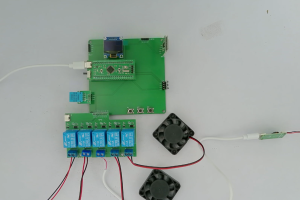设计说明书
总字数:18000+
摘要
随着蚕桑产业规模化发展,小蚕共育阶段的环境条件对蚕体发育及成活率影响显著,精准调控温湿度、CO₂浓度等参数成为优质共育的关键。传统共育室环境管理依赖人工巡检与手动调节,存在精度低、响应滞后等问题,难以满足小蚕对稳定生长环境的需求。
基于 STM32F103C8T6 单片机的小蚕共育室环境监测系统,整合 DHT11 温湿度传感器、SGP30 CO₂传感器、OLED 显示模块、按键及 ESP8266 WiFi 模块,实现了共育室环境的智能化监测与调控。系统核心功能包括:通过 DHT11 实时监测温湿度,当检测值超出预设范围时,自动启动加热、制冷、加湿或除湿设备进行动态调节;借助 SGP30 检测 CO₂浓度,超过最大值时触发通风装置换气;按键可手动设置各参数阈值及控制设备启停;OLED 显示模块实时展示温湿度、CO₂浓度及设备运行状态;ESP8266 WiFi 模块将数据上传至手机端,支持远程查看数据、设置阈值及控制设备。
该系统的实现,有效提升了小蚕共育室环境调控的精准性与自动化水平,通过多参数协同监测与智能响应,为小蚕生长提供了稳定环境,降低了人工成本,同时为蚕桑养殖智能化设备的研发提供了参考,具有较高的产业应用价值。
关键词:小蚕共育室;环境监测系统;智能调控;WiFi 远程控制;阈值设置
ABSTRACT
With the large-scale development of the sericulture industry, the environmental conditions during the young silkworm co-cultivation stage have a significant impact on silkworm development and survival rate. Precise regulation of parameters such as temperature, humidity, and CO₂ concentration has become the key to high-quality co-cultivation. Traditional environmental management of co-cultivation rooms relies on manual inspections and manual adjustments, which have problems such as low accuracy and delayed response, making it difficult to meet the needs of young silkworms for a stable growth environment.
The young silkworm co-cultivation room environment monitoring system based on the STM32F103C8T6 microcontroller integrates a DHT11 temperature and humidity sensor, SGP30 CO₂ sensor, OLED display module, buttons, and ESP8266 WiFi module to realize intelligent monitoring and regulation of the co-cultivation room environment. The core functions of the system include: real-time monitoring of temperature and humidity through DHT11, and when the detected values exceed the preset range, automatically starting heating, cooling, humidification, or dehumidification equipment for dynamic adjustment; detecting CO₂ concentration with SGP30, and triggering ventilation devices for air exchange when it exceeds the maximum value; buttons can manually set various parameter thresholds and control the start and stop of equipment; the OLED display module displays temperature and humidity, CO₂ concentration, and equipment operating status in real-time; the ESP8266 WiFi module uploads data to the mobile phone, supporting remote data viewing, threshold setting, and equipment control.
The implementation of this system has effectively improved the accuracy and automation level of environmental regulation in young silkworm co-cultivation rooms. Through multi-parameter collaborative monitoring and intelligent response, it provides a stable environment for the growth of young silkworms, reduces labor costs, and provides a reference for the research and development of intelligent equipment for sericulture, with high industrial application value.
Keywords:young silkworm co-cultivation room; environment monitoring system; intelligent regulation; WiFi remote control; threshold setting
目录
第1章 绪论
1.1 研究的目的及意义
1.2 国内外发展情况
1.2.1 国外研究现状
1.2.2 国内研究现状
1.3 本文主要研究内容
第2章 设计思路与方案论证
2.1 主要元器件选择
2.1.1 主控芯片选择
2.1.2 温湿度检测模块选择
2.1.3 CO₂检测模块选择
2.1.4 显示模块选择
2.1.5 无线通信模块选择
2.1.6 按键模块选择
2.2整体设计方案
第 3 章 硬件设计
3.1 主控电路模块
3.2 温湿度检测模块电路
3.3 CO₂检测模块电路
3.4 显示模块电路
3.5 WIFI 模块电路
3.6 按键模块电路
3.7 温湿度调控执行模块电路
第4章 系统程序设计
4.1 编程软件介绍
4.2 系统主流程设计
4.3 独立按键
4.4 OLED显示流程设计
4.5 温湿度检测模块子流程设计
4.6 SGP30模块子流程设计
4.7 WiFi模块子流程设计
第 5 章 仿真测试
5.1 整体仿真测试
5.2 温湿度检测与调控联动功能测试
5.3 CO₂检测与通风联动功能测试
5.4 按键设置功能测试
5.5 显示模块功能测试
5.6 WIFI 模块远程控制功能测试
第 6 章 实物测试
6.1 整体实物测试
6.2 温湿度检测与调控联动功能测试
6.3 CO₂检测与通风联动功能测试
6.4 按键设置功能测试
6.5 显示模块功能测试
6.6 WIFI 模块远程控制功能测试
第6章 总结与展望
6.1 总结
6.2 展望
致谢
参考文献
附录
附录一:原理图
附录二:PCB
附录三:主程序

